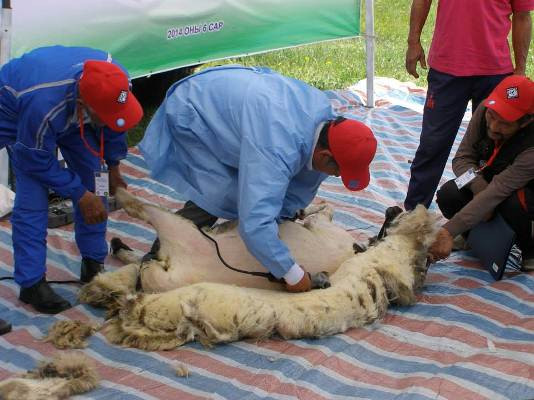We help to insulate homes in Mongolia by wool
Published: Jan 20, 2015 Reading time: 3 minutes Share: Share an articleIt is hard to believe that winter temperatures in Mongolia can fall to thirty degrees below zero, and even more inconceivable that most residents’ houses have no insulation. Heating have costs increased steeply, forcing many Mongolian families to seek methods of saving money, while still staying warm. People in Need together with EU promotes the use of wool from local sheep as the best and least expensive material for home insulation.

Most of Mongolians live in an outdated block of flats, which are very expensive when it comes to energy. They are forced to seek out new methods of warming their houses, because of the deregulation of energy prices. "This was the reason we tried to replace the import of expensive and often environmentally unacceptable materials with local materials beginning in January 2013," explains Juraj Drábik, who worked for a year and half as a member of People In Need’s Mongolian team.
He sees a reliable alternative in sheep wool, which is used for insulation after a series of necessary treatments that occur in Europe. "There is lots of wool in Mongolia, and there are about five sheep per head, so it is an accessible and environmentally-friendly material, which can replace the import of fiberglass from China or the purchase of Russian rock wool," he says.
Wool in Mongolia is processed minimally
Although the wool in Mongolia is one of the country’s main products, it is not widely used. There is a low demand for wool and, subsequently, a low profit for those who supply it.. People in Need decided to embrace wool’s potential, and focus on the process of treating wool as a thermal insulating building material. PIN emphasized the development of all supply chains, which include individual sheep breeders, small and medium-sized companies, and institutions like state offices and schools.
"From sheep breeders, who produce the primary material, we proceeded to enterprises, which process some crude wool and produce insulation from that, up to companies, which will use that wool while they build new buildings or repair the old ones. We also cooperate with regulatory offices, because it is necessity to standardize and certify this new product,” clarifies the project coordinator, Amgalan Ariunbold.
Factories employ three hundred people
 Since the concept of green and low-energy building is quite new, People in Need project funded by European Commission through Switch Asia had to formulate a marketing campaign that would present the final product to the public. "The campaign included articles in magazines, TV slots, booklets, and even a documentary film," says Amgalan Ariunbold. The new product will be produced in four or five factories at different locations in the Mongolian territory in the future, where they should employ around three hundred people.
Since the concept of green and low-energy building is quite new, People in Need project funded by European Commission through Switch Asia had to formulate a marketing campaign that would present the final product to the public. "The campaign included articles in magazines, TV slots, booklets, and even a documentary film," says Amgalan Ariunbold. The new product will be produced in four or five factories at different locations in the Mongolian territory in the future, where they should employ around three hundred people.
Cooperation for this initiative is thriving at the political level as well. "We succeeded in procuring the national product certification - thanks to that, the wool insulation can be considered a standard material in the building industry,” noted the head of the Mongolian mission of People in Need.
Training for nomadic herdsman
![]() Long distances and lack of infrastructure cause large gaps in the living standards of inhabitants in the main city and of those in the countryside. Therefore, People in Need also focuses on the work of nomadic herdsman, who produce the main material for the new product. "This past summer we organized the training of two hundred herdsman from the northern region of Mongolia about the right way to shear sheep. This year, we plan to organize another training during which the herdsman will learn how to sort wool, thus increasing its value,” says Amgalan Ariunbold.
Long distances and lack of infrastructure cause large gaps in the living standards of inhabitants in the main city and of those in the countryside. Therefore, People in Need also focuses on the work of nomadic herdsman, who produce the main material for the new product. "This past summer we organized the training of two hundred herdsman from the northern region of Mongolia about the right way to shear sheep. This year, we plan to organize another training during which the herdsman will learn how to sort wool, thus increasing its value,” says Amgalan Ariunbold.
"The processed wool should serve as the insulation material of those houses occupied by poor people in the countryside or in the dwellings of ex nomads living in the periphery of Ulaanbaatar. The warm insulation should drastically increase the quality of life in the country, where the winter can last eight months,” she says.
